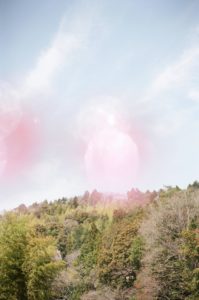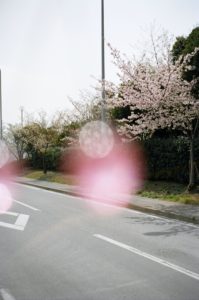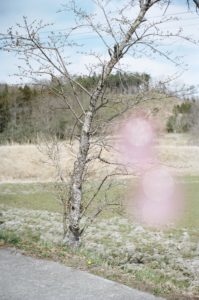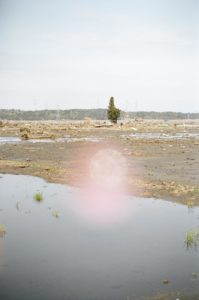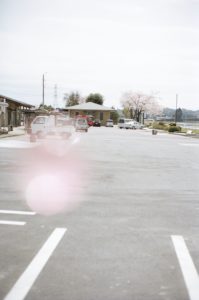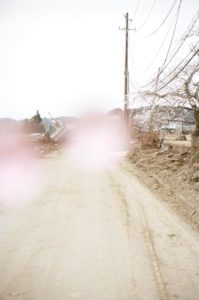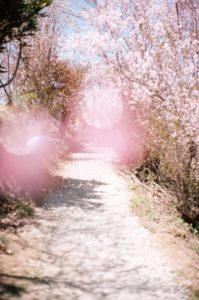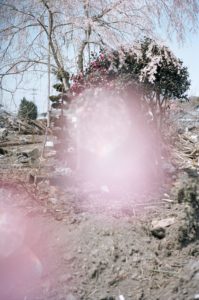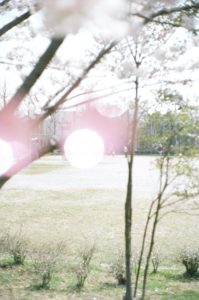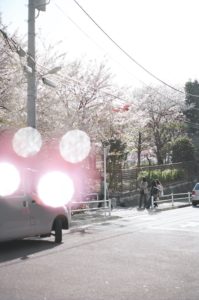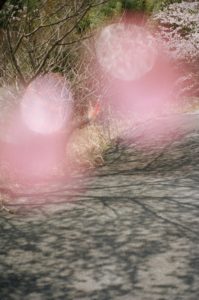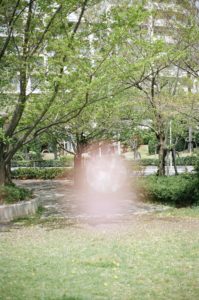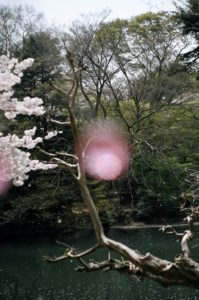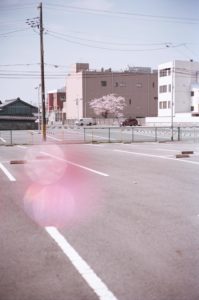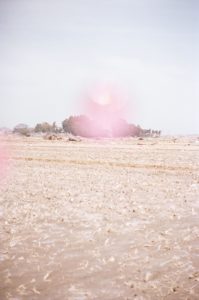Omori has said, “it was pointless to approach photography in the same way as before 3.11.” The earthquake that hit the Tohoku region on 3.11.2011 has had a great impact on both documentary and fine art photography in Japan. Omori’s “Everything happens for the first time” was shot right after the earthquake and first shown at his solo exhibition at the Pola Museum, Tokyo in the same year. In 2013, the complete series was presented at a group show entitled “every stroller can change the world” at the Tokyo Metropolitan Museum of Photography.
During these past ten years, Omori has undertaken a project to photograph cherry blossoms, which are a symbol of great importance in Japanese culture. Shortly after the Tohoku Earthquake, he decided to photograph these flowers in Fukushima Prefecture, which experienced the heaviest damage from the earthquake, tsunami, and subsequent nuclear plant meltdowns. These photographs of cherry blossoms also feature the phenomenon of halation. Glowing blurs of light that bloom across these images and obstruct one’s view suggest an unseen yet palpable presence, such as our collective anxiety, fear of radiation, or even our wishes for the future.
The title “Everything happens for the first time”, quoted from a verse by Borges, implies reality itself is always full of unknown, invisible elements. The photographs of Omori’s trip to Fukushima speak in a revelatory way of the true nature of reality.
Some dates and memories associate with Subete wa hajimete okoru (Everything happens for the first time)
[October 20, 2013]
On May 16, 2007, at the end of a journey that had lasted around one and a half months as I followed the blooming of the cherry trees from Kyoto to Hokkaido, I saw pale pink wild cherry blossoms sparkle as they scattered on the breeze at Shoya Park in Erimo, Hokkaido. There is no other flower in the history or culture of Japan that has preoccupied the minds or consumed the thoughts of people more than the cherry. For close to ten years I have taken photographs of the cherry blossoms, wondering whether it is possible to temporarily set aside that preoccupation as one views them. But when I saw those petals sparkling in the morning sunlight and experienced their sheer beauty, I decided that my journey in pursuit of the cherries would come to an end. I believed myself to be focused only on looking, but when I thought about it, I realized I had been walking and breathing at the very same time. As I made my way up to the top of a small hill, various sounds reached my ears: my own footsteps on the road, the faintly audible distant sounds of ocean waves and children’s voices from a nursery school, birds singing. And the smell of the soil, the trees the sea breeze. I then realized something obvious: that there are so many things in this world that you can’t see with your eyes or capture in a photograph. Realizing that made me happy. I could see the Pacific Ocean from the top of the hill.
On August 31, 2010, I was in Los Angeles, where I had traveled to meet with the Mexican-American novelist Salvador Plascencia, and in a toyshop in El Mercado de Los Angeles on the corner of East 1st and Lorena Streets, I found a toy made from pink plastic balls suspended like a pendulum. It was the clackers that had been all the rage when I was a small child. I immediately bought the toy and started playing with it, releasing one of the balls and watching it hit the other one with a clacking sound. From the balcony of the second floor of the market, I could see the street below bathed in the afternoon light, and when I held the pink translucent balls aloft, the world sparkled and shimmered and I remembered being a small child and how I used to look at various objects through a piece of ice or glass. This scene, which I was supposedly seeing for the first time, was for some reason very nostalgic for me and I took a picture of it. Later, as I talked with Salvador and his friends about the Manchester rock band the Smiths and the Mexican football player Dos Santos, we drove around the east side of the vast city of Los Angeles.
On March 11, 2011, when the earthquake hit and I felt my eighth-floor apartment in Urayasu, Chiba shaking, I heard the sounds of animals crying, people yelling, and the water in the bathtub moving. On my way to pick up my daughter from primary school, I saw muddy water gushing up through cracks in the road, the result of the ground liquefying. That night I walked around my apartment in my shoes, cleaning up the broken dishes and putting the books back in the bookcase. For a few days my neighborhood was covered with dust, turning everything a hazy white. Hearing that so many people had died, I felt sad and shed tears. My apartment had no running water for a week, and each time I went to do my business in the temporary toilets, I would go down and up the stairs carrying toilet paper. There were many things that I was experiencing for the first time and there were nights when my anxiety kept me awake. As the days passed by at a bewildering pace, I felt as if I was barely hanging onto the sensation that my body belonged to me. When I was face-to-face with my family and friends and having a conversation, I experienced a real sense of being alive. But as news trickled in -about the Fukushima nuclear power plant accident, what had happened gradually became clearer, something that resembled a chasm between my physical self and a world that kept on changing grew even wider. The lights in central Tokyo were turned off and the city went dark. Even in late March the cold days continued, but watching the gradually swelling buds on the cherry trees in my neighborhood reminded me of all sorts of things, and I decided, with the cherries pointing me the way, to make the journey to Fukushima. April arrived, the trees in Tokyo and Urayasu bloomed, and the petals scattered on the breeze. On April 14th, I heard on the radio that the cherry blossoms in Onahama in Iwaki City, Fukushima were just about to peak, and I headed north in my car along the Joban Expressway.
On October 13, 2013, I participated in the Onahama Hon-cho Street Arts Festival and exhibited Subete wa hajimete okoru. Various people gave me feedback on my work but I was most affected by two photographs that do not even exist. Shiga Kimie, who works at a processed seafood store in Town Mall Respo, the exhibition venue, looked very carefully for a long time at the exhibited prints and photo collections, then told me that she couldn’t forget the beauty of Tomigaura Park in Onahama where she went with her grandchild in the spring of 2011 to see the cherry blossoms. “If you had gone there and taken a photograph as part of your “Subete … ” series, how I would love to have seen what you came up with,” she said. Then, Aota Kumiko who used to live in Okuma in Futaba and was evacuated to Kitakata, remarked, “You haven’t got any photos of Okuma in this series, do you ... ” I didn’t, or couldn’t, go to either of those places in the spring of 2011. I listened to these two people who were thinking about “photos that could have existed but were never taken” as they looked at “photos that exist here and now” and I honestly felt glad that I had been able to exhibit these pictures in Onahama.
Katsumi Omori
